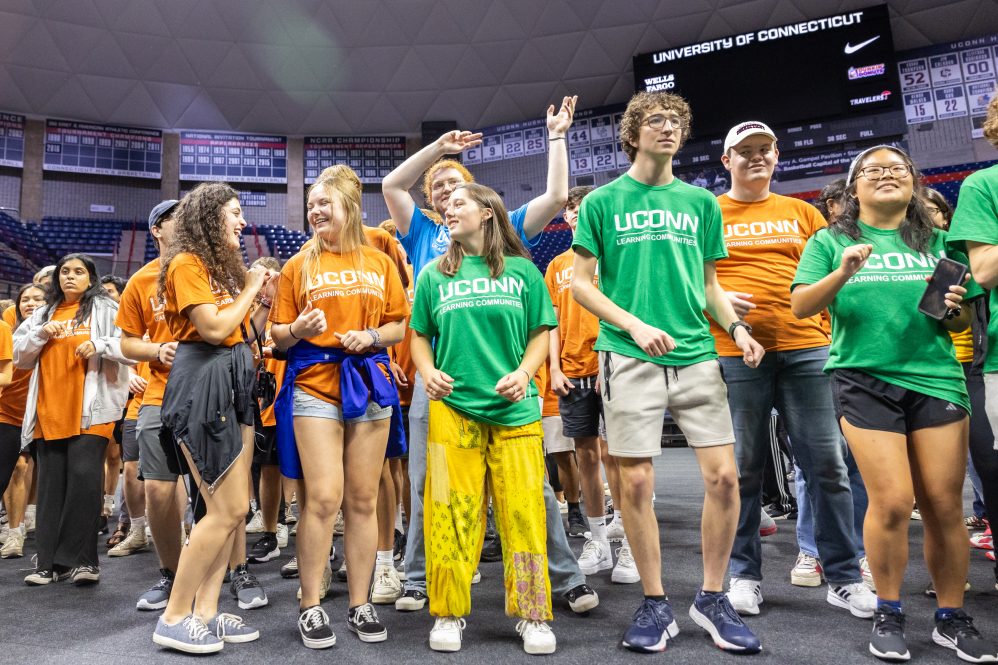UConn is being recognized on a national stage for the strength of its Learning Communities program, which helps students transition to a university setting by connecting them with faculty, staff, and student leaders of various affinities and identities.
U.S. News & World Report’s recently released annual rankings listed UConn’s learning communities as No. 25 among all public institutions, the first year in which the program has received a ranking.
U.S. News started assessing learning community programs at colleges and universities four years ago, and institutions can only be considered if they receive 10 or more nominations from presidents, provosts, and admissions deans at peer institutions.
At UConn, the Learning Communities and Special Interest Housing programs are among many approaches in place to provide a holistic experience for students, fostering both their academic and social success.
“UConn Learning Communities integrate students with faculty, staff, and programs from across campus to provide enriched, personalized, and tailored support,” says Melissa Foreman, director of the UConn Learning Communities program.
“Faculty and graduate student leadership fosters students’ intellectual growth, and peer leaders serving alongside dedicated staff create layers of mentoring and support tied to themes of excellence at our institution, such as global health, innovation, and sustainability,” she says. “Through this transformative approach, students transcend disciplines, embracing unique and impactful journeys that define their educational experience.”
UConn’s Learning Communities and Special Interest Housing programs both expanded this semester at Storrs with a new residential Learning Community, BSOUL House (Black Sisters Optimizing Unity & Leadership; and the Wellness Community, a Special Interest Housing option.
The new BSOUL House, directed by School of Pharmacy Assistant Professor of Pharmacy Practice Chinenye Anyanwu, officially launched with a celebration last spring and opened for fall semester with 54 residents in the Peter J. Werth Tower.
It is open to first- and second-year undergraduate women interested in supporting the scholastic efforts of female students who identify as African American/Black. In addition to academic and social support, BSOUL participants receive access to research opportunities, professional development, co-curricular activities, and other programming.
BSOUL’s roots can be traced to a First-Year Experience course titled “Black Women Voices in Higher Education.” Led by the UConn’s director of Diversity and Inclusion Initiatives Dr. Jonelle Reynolds and several undergraduate student mentors, it started as a non-residential learning community and generated such interest and support inside and outside the university that it was transitioned into the new residential community.
New non-residential learning communities were also introduced at UConn Stamford, adding two more options in addition to the Business Connections Learning Community, which was launched in 2018 as the first such program at the campus.
The first new Stamford offering is La Comunidad Intelectual, which brings together students interested in learning about and nurturing a sense of identity for those with Latine identities, exploring Caribbean and Latin American diasporas, and being empowered to engage in meaningful campus and community opportunities. It is modeled on a learning community of the same name at Storrs.
The second is MOCX: The Men of Color Experience, which provides a foundation for academic success and a community of social and emotional support on the campus, similar in some ways to the residential ScHOLA2RS (Scholars) House at UConn Storrs.
UConn has 34 residential and non-residential learning communities with more than 2,800 student participants joined by common academic majors, cultural identities, social pursuits, and interdisciplinary interests.
Also new this fall: The Wellness Community, run by Residential Life and Student Health & Wellness (SHaW) to support students with tools and services for their mental, physical, and emotional well-being. It is the newest offering in UConn’s Special Interest Housing program.
Special Interest Housing is separate from the Learning Communities programs but they complement each other in many ways, with both helping students build a sense of belonging in their communities while extending their access to services, support, and resources.
The new Wellness Community, which began with 43 students, houses first-year and returning students in Troy/Shakespeare halls in the West Campus complex. It is situated close to the Student Recreation Center and several other helpful resources, including the Substance-Free Living Community also sponsored by UConn Student Health & Wellness (SHaW).
“There is not just one pathway to health,” SHaW Executive Director Suzanne Onorato says. “The Wellness Community is a vibrant, engaged community that provides opportunities for students to explore different pathways to strengthen individual health and well-being, to connect with others, and to be a part of a supportive, thriving living environment.”
The Wellness Community also supports the legacy of Alexandra Frey, who lost her life to suicide at age 25 despite engaging in therapy and various treatment programs to address mental health challenges. Her father, UConn alum Dan Frey ’86 (BUS) and his wife, Diana Grant, established a memorial fund in her name that was key to supporting the new residential wellness community.
In addition to the new Wellness Community and Substance-Free Living Community, UConn offers special interest housing communities for veterans, gender-inclusive students, and students who use American Sign Language and/or work to encourage accessibility for the Deaf community.



